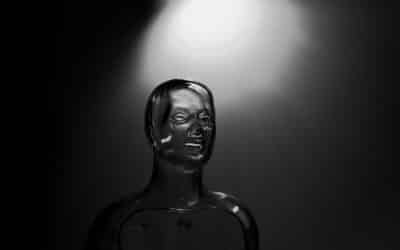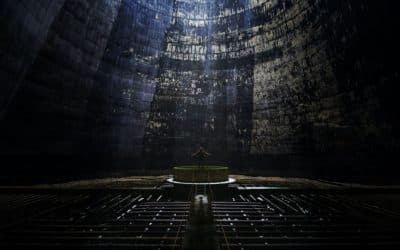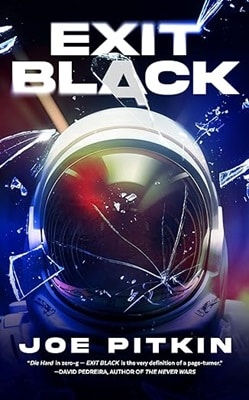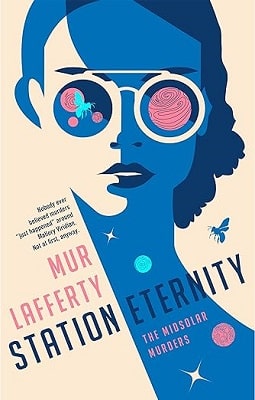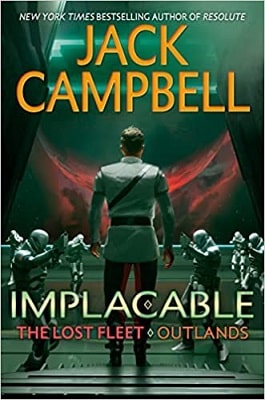
Feature
Religiosity in Fiction
Benjamin X. Wretlind
If you haven’t yet discovered the detective’s solving crime in Urban Fantasy novels, it’s time to get on the train. Just be aware the train may also be occupied with any number of fantastical creatures. Word of advice: give the dragon his own car on the subway, that’s just common sense.
In a house on a street in a city in a state, there once was a man who convinced dozens of people to leave their bodies behind so they could join the evolutionary state above human. Their cool new ride was soon to arrive hidden in the tail of a comet, and once they were on board, they would ascend to a new level of awareness. They would graduate from their classroom on Earth and leave this world in the dust.
They say reality is sometimes stranger than fiction, and while this sounds like science fiction, most of us would recognize the reality. The house was in Rancho Santa Fe, California, the year was 1997, and it was a man named Marshall Applewhite who convinced 38 other very intelligent people to eat a concoction of apple sauce or pudding mixed with phenobarbital so that they could join other Next Level Bodies on board a UFO hidden in the tale of Comet Hale-Bopp. It was a cult named Heaven’s Gate.
The term cult often has a negative connotation. Oxford defines one as “a system of religious veneration and devotion directed toward a particular figure or object.” In contrast, religion is “the belief in and worship of a superhuman controlling power, especially a personal God or gods.” The “personal God or gods” part of that means it could be anything, from the Christian God to the Flying Spaghetti Monster or to something like consumerism. It can also be defined as that “particular figure or object” mentioned in the definition for a cult. Marshall Applewhite—aka Do—for example.
Religion is what it is, and it is personal. Much like Heaven’s Gate, we can read into a “cult” as nothing more than an invented religion—one that may appear strange to outsiders. While cults are looked at as offshoots of a religion, many religions we now see as mainstream in fact started off as a cult. Scientology and the Unification Church are often referred to as cults, but in fact, Christianity was considered a cult in its earliest days. So was Islam. And Baptists. Quakers, even.
In the realm of fiction, religion is often portrayed in black and white tones with a distinct good versus evil motif. There are multiple examples in fiction. Horror is rife with religion as it lays the groundwork for whatever evil lurks in the corners (think: H.P. Lovecraft’s Cthulhu mythos or William P. Blatty’s Exorcist). Fantasy, too, has its fair share of religions, many of which are very similar to Native American beliefs and the worship of nature. The Wheel of Time series by Robert Jordan springs to mind immediately. But religious cults and religions are not confined to horror or fantasy novels. They can, in fact, act as both antagonist and protagonist within any genre and certainly bring a different level of realism to the sci-fi thriller reading experience.
After all, science fiction has a strong link to anthropology, and anthropology is all about the study of human societies, cultures, and their development. Within that study lies not only language, traditions, and behavior, but also religion and religious development (i.e., religions that start off as cults).
So, what fictional religions exists within sci-fi and sci-fi thrillers? Is it really that prevalent?
We don’t look to science fiction to directly address religious motifs, but they are often there, nonetheless. Technological changes which challenge religious attitudes are common, and we can probably find examples of many of the main themes in religion, from creationism (2010 by Arthur C. Clarke), to Messianism (Dune by Frank Herbert), to reincarnation (as Philip K. Dick explored in Ubik).
We can also look beyond the major Earth religions to find other influences present in fiction. According to The Pew Research Center, it is estimated that 84% of the world’s population is affiliated with Christianity, Islam, Hinduism, Buddhism, or some form of folk religion, while the rest have no religious affiliation (e.g., atheists, agnostics, humanists).
There are around 10,000 distinct religions worldwide. Of those, monotheism (i.e., the worship of a singular deity) may lay claim to the most followers, but through a pure numbers game, most religions eschew the idea of one deity and can be classified as either polytheistic (many gods), henotheistic (one god but open to the idea of more), animistic (innumerable spiritual objects), pantheist (it’s all God) or some combination thereof. Keep in mind that the numbers given by The Pew Research Center do not include offshoot cults. Of those, there are probably…a heck of a lot.
Arguably, the most prominent religion within science fiction is that which exists within the Star Wars universe in the form of the Jedi and the Sith. Even if you have never seen the movies, read any of the books, or indulged in the television shows, the “Force” is a ubiquitous presence in our culture. Memes and t-shirts and bumper stickers and anything else that can hold licensed content extoll the virtuous calling “May the Force Be with You.”
So, what is it about this one fictional religion that so strikes a chord in our collective minds? Perhaps it’s as simple as good versus evil, the light versus the dark, the protagonist versus the antagonist. Or, it could be much more complicated, a reflection on our societal traditions and mores laid out for us in a digestible philosophy that can be swallowed up by the youngest of fans. When I took my oldest to see The Phantom Menace when he was just four, even he understood.
Some arguments could be made that the Force as depicted in Star Wars is more magical than supernatural, a fantastical deus ex machina to solve certain problems in the plot. However, if we look back at our definition, the “belief in… a superhuman controlling power” really strikes a chord with how the Force is depicted in the Star Wars universe. It is not only used to solve problems but create them as well. The Force adds tension, and tension drives story.
Less fantastical and more recognizable to our current religions on Earth, Frank Herbert’s Dune borrows extensively from Islam, Christianity and Buddhism to create religions within the novels that act as an overarching reason why characters do what they do. In this case, the beliefs are guiding lights and behavior modifiers. The acceptance of Muad’Dib created an offshoot cult of the original Fremen religion and later spilt into variants such as the Cult of Alia and Cult of Sheeana.
There are, within the Dune universe (all books, etc. combined), approximately 128 religions mentioned, the most prominent being the beliefs of the Fremen and the Bene Gesserit. While much of the beliefs of all the other mentioned religions are not laid out in detail within the Dune universe, much is known about both what the Fremen believe and the teachings of the Bene Gesserit. Dune would probably have been an entirely different novel had these two belief systems been the central focus. Like the Force in Star Wars, the beliefs of the characters drive their actions and that creates tension.
Religions clash, of course. We can see that especially now and looking back in history, it has been this way for thousands of years. In Kevin J. Anderson’s Terra Incognita, two churches which essentially believe the same thing—that God had two sons—are at odds with each other and consider the teachings of the other to be pure heresy. Terra Incognita uses religion as the carrier for the plot from beginning to end. A literal dues ex machina is revealed near the end when God shows up with a third son and a new religion is formed by merging all beliefs.
Religious creation or invention is explored in other novels, as well, and some of those novels have had an impact on our present culture. Robert A. Heinlein’s 1961 science fiction novel Stranger in a Strange Land gives us an example of religion as a central theme within a book, but rather than provide a narration based on an existing religion, Heinlein uses the journey of the main character Valentine Smith to establish a new religion on Earth based on the teachings of many sects. One of the strangest—and one which might be considered the more influential to Smith—is a religion called the Fosterite Church of the New Revelation. Eventually, Smith creates a “Church of All Worlds,” a mishmash of revivalism, paganism, and the teachings of Fosterites. As proof of literature’s impact on society, Heinlein’s novel directly contributed to a 501(c)(3) neopaganistic church currently operating as, you guessed it, The Church of All Worlds.
A less dramatic but still powerful religion served as the focal point of Octavia E. Butler’s Parable of the Sower. In this novel, the daughter of a Baptist minister, Lauren Olamina, eschews the false hope provided by Christianity in the midst of an apocalyptic world. After dealing with her own conflicted feelings, Lauren eventually forms a religion—which can be loosely called the formation of a cult—called Earthseed. The arc of the novel is the main character’s journey to take her ideas and grow them into a true religious community with a growing set of converts. The comparison and contrast between Earthseed and Christianity is woven throughout the novel and leads us to a satisfying conclusion. Interestingly enough, Butler’s work inspired the Terasem Movement, which seeks to develop humanity through technology and to bridge the gap between science and religion (see Jessica Roy’s article in Time “The Rapture of the Nerds” from 2014).
More modern examples of religion and religious cults within science fiction thrillers can be found in such novels as The Stand by Stephen King and (one of my favorites) Blasphemy by Douglas Preston. In the latter novel, a Nobel Laureate leading a research team at the world’s largest supercollider manipulates the system to create a new religion based on science. However, the main character’s efforts have unintended consequences with the establishment of an entirely new cult with the main character serving in a messianic role.
Many themes can be found inside science fiction thrillers, but the battle between good and evil—the fight between the protagonist the antagonist—is the crux of just about every story ever told. As religion is so focused on these concepts, it is no wonder that its very existence peppers our science fiction and adds spice to the characters. Can you tell a story without religion? Absolutely, but even in the lack of a codified, structured religious system, there still exists a conflict between the light and the dark, whether it’s internally shown in a character’s thoughts or externally shown across the universe in battles between species. That conflict often creates offshoot cults. The journeys of the characters are amplified or even modified by these motifs with the result being dynamic characters in a well-rounded novel.
Authors of sci-fi thriller novels often give readers much deeper novels by exploring philosophical elements that go far beyond simplistic tropes. I have mentioned probably less than one percent of one percent of all the novels within the genre that touch on religion or religious cults, and any reader out there can probably name a dozen more. As you read your next science fiction thriller, attempt to pull out what themes are present. You may be surprised to find just how many reads explore our future by using religion and cult creation as a plot device.
About the Author
Benjamin X. Wretlind is an author and organizational psychologist living in Colorado Springs who currently builds and facilitates leadership courses for staff at Yale University. His latest novel, Out of Due Season: The First Transit, kicks off an anthropological science fiction series to be told over eight books. Benjamin has been–at different times of course–a fry cook, range boy, reservations agent, room service attendant, banquet server, meteorologist, instructor, program manager, curriculum developer, process improvement consultant, learning manager and organizational psychologist. He also plays with sharp woodworking tools, occassionaly runs with scissors and paints anything but animals or people. You can learn more about all of Benjamin’s eccentricites (and novels) at bxwretlind.com or follow him on Twitter @bxwretlind.

More Sci Fi Thriller Features
Space Opera Thrillers
Nail-biting tension in worlds of spaceships and doom
Artificial Intelligence in Thrillers
AI and Identity in Thrillers
Sci-fi Mysteries
Why we love science fiction mysteries


